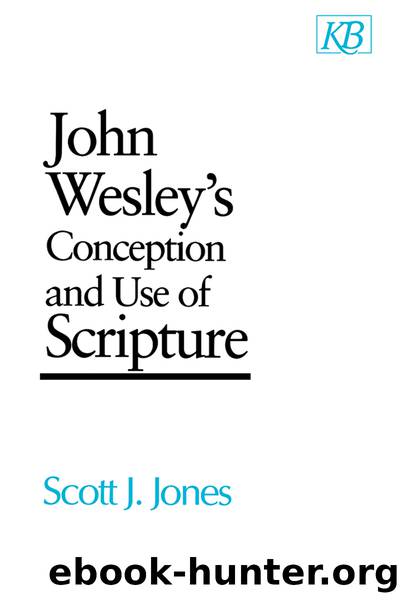John Wesley's Conception and Use of Scripture by Jones Scott J.;

Author:Jones, Scott J.;
Language: eng
Format: epub
Publisher: Abingdon Press
Published: 1995-08-15T00:00:00+00:00
Wesleyâs Use of the Apocrypha
The Apocrypha consists of those books regarded as canonical Old Testament material by the Roman Catholic Church but not included in the biblical canon by Protestants or Jews. Orthodox Christians call them âDeutero-Canonical,â including them as part of the Bible but placing them âon a lower footing than the rest of the Old Testament.â34 Wesleyâs attitude toward the Apocrypha is not easy to ascertain. The relevant evidence consists of two types: his use of Apocryphal texts, and the teachings of the Church of England, which he often defended in general. Wesleyâs use of the Apocrypha can be understood by reference to eleven instances that occur within the sample of works analyzed for this study.35 In all of his sermons, there are only fifty-two such uses. Of these, thirty-five refer to the Book of Wisdom, with Wisdom 9:15 being Wesleyâs favorite verse in the Apocrypha. He quotes it eleven times.36 The significance of these uses lies not in their number, but in the way in which Wesley quotes from this material.
Wesleyâs use of Apocryphal texts is very similar to his use of canonical texts in three respects. First, he uses Apocryphal texts in a semantic way side by side with canonical texts. Frequently there is no formal distinction to indicate they are from different types of sources. Consider §51 of An Earnest Appeal:37 âBear with me yet a little longer: my soul is distressed for you. âThe god of this world hath blinded your eyes,â[a] and you are âseeking death in the error of your life.ââ [b] Here one quotation from 2 Corinthians is used semantically and placed in quotation marks. In the same sentence the quotation from Wisdom is used in the same way and also placed in quotation marks. The uses of the two texts are identical. In another place, two texts are paired without identifying marks. In âOn the Wedding Garmentâ38 he writes,
From the very time that the Son of God delivered this weighty truth to the children of men, that all who had not the wedding garment would be cast into outward darkness, where are weeping and gnashing of teeth,[a] the enemy of souls has been labouring to obscure it, that they might still seek death in the error of their life,[b] and many ways has he tried to disguise the holiness without which we cannot be saved.
Here the same conclusion about identical usage must be drawn. In other instances, a passage from Ecclesiasticus is used with passages from 1 Corinthians and Ecclesiastes; Wisdom 1:12 is used with Isaiah 5:20.39
Second, there is one place where Wesley explicitly cites a passage from an Apocryphal text in his sermon. Of all his sermons, this one has the most references provided by Wesley himselfâfifty-nine. One of these is a translation of the Greek word λϵγÏÎ¿Ï given in the text. All the rest refer to scriptural texts, with the exception of Wisdom 2:13-16:
The world in general were offended, âbecause they testified of it that the works thereof were evilâ [John 7:7].
Download
This site does not store any files on its server. We only index and link to content provided by other sites. Please contact the content providers to delete copyright contents if any and email us, we'll remove relevant links or contents immediately.
| Anglican | Baptist |
| Book of Common Prayer | Calvinist |
| Episcopalian | Inspirational |
| Lutheran | Methodist |
| Pentecostal & Charismatic | Presbyterian |
| Quaker | Seventh-Day Adventist |
| Shaker | Theology |
Angels by Billy Graham(1889)
How To Be Born Again by Billy Graham(1732)
Peace with God by Billy Graham(1645)
Unbroken Curses by Rebecca Brown & Daniel Yoder(1524)
God's Prophetic Symbolism in Everyday Life by Adam Thompson & Adrian Beale(1449)
The School of Biblical Evangelism by Ray Comfort(1396)
Call by Rick Joyner(1372)
Martin Luther: The Man Who Rediscovered God and Changed the World by Eric Metaxas(1356)
Power over the Enemy by John Osteen & Joel Osteen(1317)
Jonathan Edwards: A Life by Marsden George M(1195)
Fresh Wind, Fresh Fire by Jim Cymbala(1192)
Prayers That Bring Healing and Activate Blessings: Experience the Protection, Power, and Favor of God by John Eckhardt(1190)
Liturgy of the Ordinary by Tish Harrison Warren(1183)
The Supernatural Power of a Transformed Mind Expanded Edition: Access to a Life of Miracles by Bill Johnson(1174)
Unmasking the Devil: Strategies to Defeat Eternity's Greatest Enemy by John Ramirez(1163)
An Altar in the World by Barbara Brown Taylor(1154)
Reformation Theology by Littlejohn Bradford(1147)
Seeing the Voice of God: What God Is Telling You through Dreams and Visions by Smith Laura Harris(1104)
Martin Luther by Mansch Larry D.; Peters Curtis H.;(1104)
